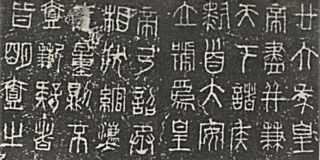Small Seal Script
| Small Seal Script | |
|---|---|
 | |
| Type | Logographic |
| Languages | Old Chinese |
| Time period | Bronze Age China |
| Parent systems |
(Proto-writing)
|
| Child systems |
Clerical script Kaishu Kanji Kana Hanja Zhuyin Simplified Chinese Chu Nom Khitan script Jurchen script Tangut script |

Small Seal Script (Chinese: 小篆, xiǎozhuàn), formerly romanized as Hsiao-chuan and also known as Seal Script, Lesser Seal Script and Qin Script (秦篆, Qínzhuàn), is an archaic form of Chinese calligraphy. It was standardized and promulgated as a national standard by Li Si, prime minister under Shi Huangdi, the First Emperor of Qin.
Before the Qin conquest of the last six of the Warring States of Zhou China, local styles of characters evolved independently of one another for centuries, producing what are called the "Scripts of the Six States" (六國文字) or "Great Seal Script". Under one unified government however, the diversity was deemed undesirable as it hindered timely communication, trade, taxation, and transportation and as independent scripts might represent dissenting political ideas, especially in areas where the suppressed Confucian tradition remained strong.
Hence coaches, roads, currency, laws, weights, measures, and writing were to be unified systematically. Characters which were different from those found in Qin were discarded and Li Si's small seal characters became the standard for all regions within the empire. This policy came in about 220 BC, the year after Qin's unification of the Chinese states, and was introduced by Li Si and two ministers.[1] The small cursive form clerical script came after the small script.[1]
Li Si's compilation is known only through Chinese commentaries through the centuries. It is purported to contain 3,300 characters. Several hundred characters from fragmentary commentaries have been collected during the Qing period, and recent archeological excavations in Anhui, China, have uncovered several hundred more on bamboo strips to show the order of the characters; unfortunately, the script employed is not the small seal script as the discovery dates from Han times.
See also
- Seal Script
- Large Seal Script
| ||||||||||
References
- ↑ 1.0 1.1 Diringer, David. [1982] (1982). The Book Before Printing: Ancient, Medieval, and Oriental. Courier Dover Publications. ISBN 0-486-24243-9.